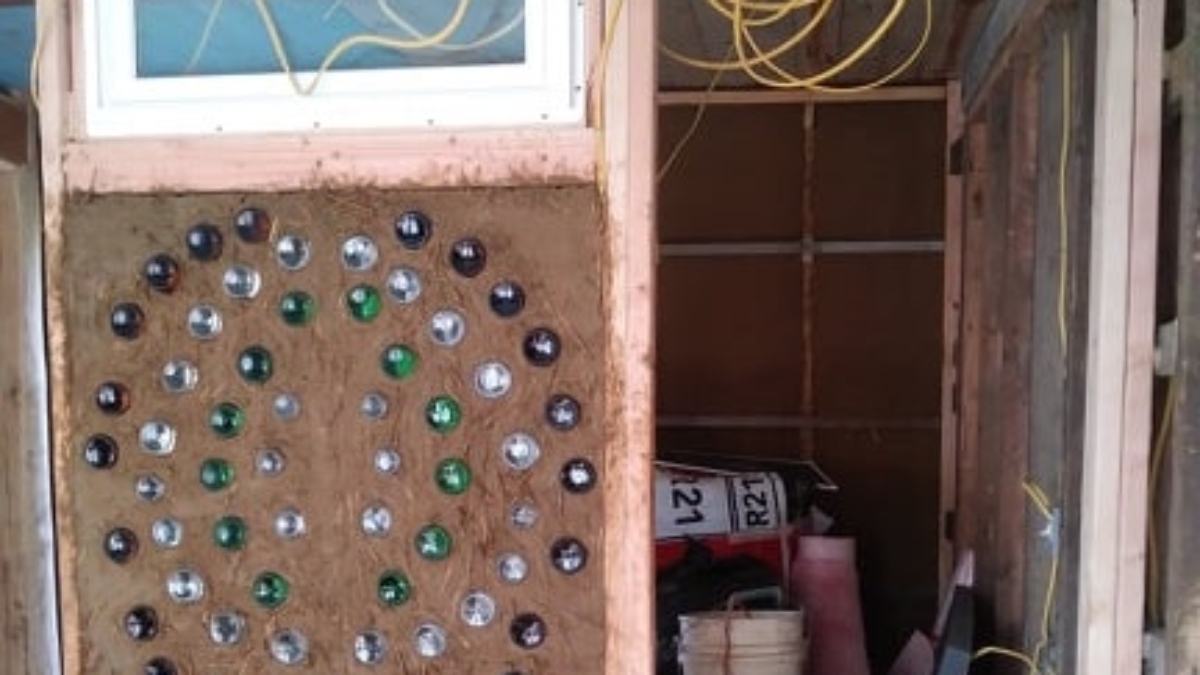Where Is Your Edge? A Dancing Rabbit Update
Published: Tue, 10/19/21

A Dancing Rabbit Update
In permaculture, the edge between different habitats is where the most change and diversity happens. And SubHub being on the edge of a new neighborhood in the village certainly fits that description. Liz here, bringing you news about our SubHub building project that has leaped forward this past building season, as well as the latest from Dancing Rabbit.
Everything is a rush right now to prepare for colder temperatures. September and October are perfect months for plastering because the humidity has died down and it’s not as hot. Lower humidity allows clay and lime plaster to dry thoroughly and lower temps make sure that the plaster doesn’t dry too fast, causing cracks.
So along with all of us as individuals ordering and stacking winter firewood for our own homes, the crew has been busy plastering over at SubHub. We finished plastering the finish layer on all of the interior, covering the rough, bumpy scratch coat with a smooth, glowing finish layer. We put a second scratch coat on the exterior west wall, which had some erosion over the last two years (it will be protected by a living patio roof, once that is built). And then we plastered a finish layer on it and painted tung oil on it to further seal it up against the weather.
No one on the crew seemed burnt out at that point, so we moved straight to designing, prepping and constructing our first bottle cob wall, one of the bathroom walls (shown in photo without a finish plaster applied). The first three feet of the wall was made of light clay and straw mixed together and then tamped into a wood form. After a day or so we took the form off and a flat wall was left to dry. We watched several batches of mushrooms and grass blades grow from it, which is a common bio process as the wall dries.
The cob plaster recipe for the bottle part of the wall was one part soaked clay mud and one-ish part sand, with lots of uncut straw. The straw ensures a lighter wall, quicker drying time and provides lots of structure for the wall to keep its shape without sagging or collapsing. Bottles have their ends cut off and then the ends are duct taped together, forming a kind of brick. Handfuls of cob plaster are smoothed around the bottle bricks, which are arranged in a desired pattern as you build the wall from the bottom. Sunlight from the hall shines through the bottle ends, letting colored light into our bathroom.
I paused my building tasks for a few days to help with a four-day women’s retreat last week. I picked up several visitors from the airport in Kirksville, an hour away. I put out breakfast for the first morning of the retreat. I offered ear acupuncture for relaxation for several days of the retreat to participants (my actual job at Dancing Rabbit is as a licensed acupuncturist). There are many Rabbits who help with these events, including Danielle Williams as the leader of this retreat.
The women’s retreat ended at 3 pm on a Sunday and at 3 pm that same day we welcomed people who signed up for our fifth and last visitor program for the year. They have been here for a week now, attending workshops on life at Dancing Rabbit and their leisure hours are filled with social fun, like a meet and greet dinner the first night, bonfires in the evening, Q and A night and coffee group in the morning. There are hikes on the prairie and hikes to the local general store, about a mile away. There are visits to our neighboring intentional communities, Sandhill Farm and Red Earth Farm. There’s even a tour of our SubHub project.
In late August the kitchen earthen floor was completely dry and ready for slate tiles to be mortared on top. A few weeks later we finished that and began grouting between the tiles. Our kitchen floor is almost ready for kitchen cabinets and an island to be installed! This will be a good project for the winter.
More projects for the winter include building a masonry heater, installing a tile shower surround and bathroom floor, and finishing the tongue and groove floors in the lofts, which Graham is working industriously to finish. Graham and Nikki will each take one of the lofts to stay in over the winter, and our building gets its first inhabitants!
In the meantime, and with only a few weeks before the end of October, Prairie and I have embarked on building a second cob bottle wall between the hall and the living room. This wall has a bigger surface area and our design is more ambitious and complicated because, well, why not? Stomping plaster in October is less fun, especially if it’s cold and misty on the day that you need to do it. But we both agree that building bottle walls is addicting and satisfies a creative itch that we both have.
Next week the village will engage in what we call “deep check-ins,” where we gather to share our experience of life in the past year or so. This act of connecting is done at least once a year and is one of the activities we engage in to build empathy and understanding between us.
This building season was the most challenging and the most satisfying for me because I decided to focus on hiring and training women and experimenting with what would make the project more woman-friendly. I also wanted to build my skills, experience and resilience for organizing larger groups and teaching natural building methods and construction skills. We had ten women work on the project this year, at all different skill levels. We had our most productive season yet and I learned so much about myself in the process. My ultimate goal is to help DR maintain a robust natural building program that is as inclusive as possible and to pass on building skills to people in the village so we can continue to build natural buildings here in an affordable way.
I recognize that I am most comfortable on the edges of things, where new things are happening and the going is rough and rewarding. This is what drew me to live at Dancing Rabbit in the first place. Knowing this about myself helps me understand the permaculture concept of what is happening on the edges of habitats, where there is more diversity in plant and animal life and more rapid changes are forming.
If you are interested in social permaculture, take a few minutes to think about what your edge might be. It could be something you have always dreamed of doing. It could be a superpower you know you have that is underutilized and could be what boosts an idea into fruition.
 Liz Hackney is the owner/builder of SubHub, a community building that will eventually host a co-op kitchen and become a focal point for mutual aid
projects, classes and guest speakers. You can see her walking her terrier, Roxie, several times a day around the village.
Liz Hackney is the owner/builder of SubHub, a community building that will eventually host a co-op kitchen and become a focal point for mutual aid
projects, classes and guest speakers. You can see her walking her terrier, Roxie, several times a day around the village.


